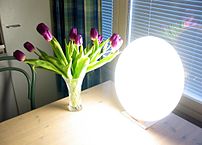 Image via WikipediaI have friends who suffer from SAD (Seasonal Affective Disorder) and for a few years we took to reminding him/her in the winter, that they felt this same way the year before.
Image via WikipediaI have friends who suffer from SAD (Seasonal Affective Disorder) and for a few years we took to reminding him/her in the winter, that they felt this same way the year before. Not to minimize the impact this disorder puts on people, but just reminding them may ignite a spark bright enough to get them to their doctor and get the help they need. As it says in the article below, some people get relief from a little tanning or some particular lighting, but some may need medication and some extra help through these months.
Seasonal Affective Disorder
The holidays are a celebratory time for most people, but those affected by Seasonal Affective Disorder (SAD) may experience continuing episodes of depression during the late fall and winter, alternating with periods of normal or high mood the rest of the year. While the environment can trigger the disorder in some people, a new study suggests that others may have a genetic predisposition to SAD.
People living with SAD may experience oversleeping, daytime fatigue, and weight gain. Others may show symptoms associated with depression, such as decreased sexual interest, lethargy, hopelessness, suicidal thoughts, lack of interest in normal activities, and social withdrawal. Many people with SAD do not feel “normal” until May.
In the study, researchers observed 220 people, including 90 people without depression and 130 people diagnosed with SAD. In the latter group, seven people had two mutated copies of the photopigment gene in the eye, which helps detect colors. The mutation makes a person with SAD less sensitive to light.
This information one day may be used to predict whether a person may have a higher risk for developing SAD, or whether light therapy will be effective.
While researchers have not identified specific causes of the disorder, seasonal circadian rhythm interruption, as well as changes in serotonin and melatonin production, may also play a role in the disorder.
When seasonal changes trigger recurring mild feelings of depression, some people living with SAD find that light therapy—using bright lamps or scheduling more time outdoors in winter—helps to manage symptoms. If symptoms noticeably affect one’s daily living, he or she should consult a mental health professional who is qualified to treat SAD.
![Reblog this post [with Zemanta]](http://img.zemanta.com/reblog_e.png?x-id=def6e7b5-deea-471c-b16a-367c98632842)




























 My StumbleUpon Page
My StumbleUpon Page









